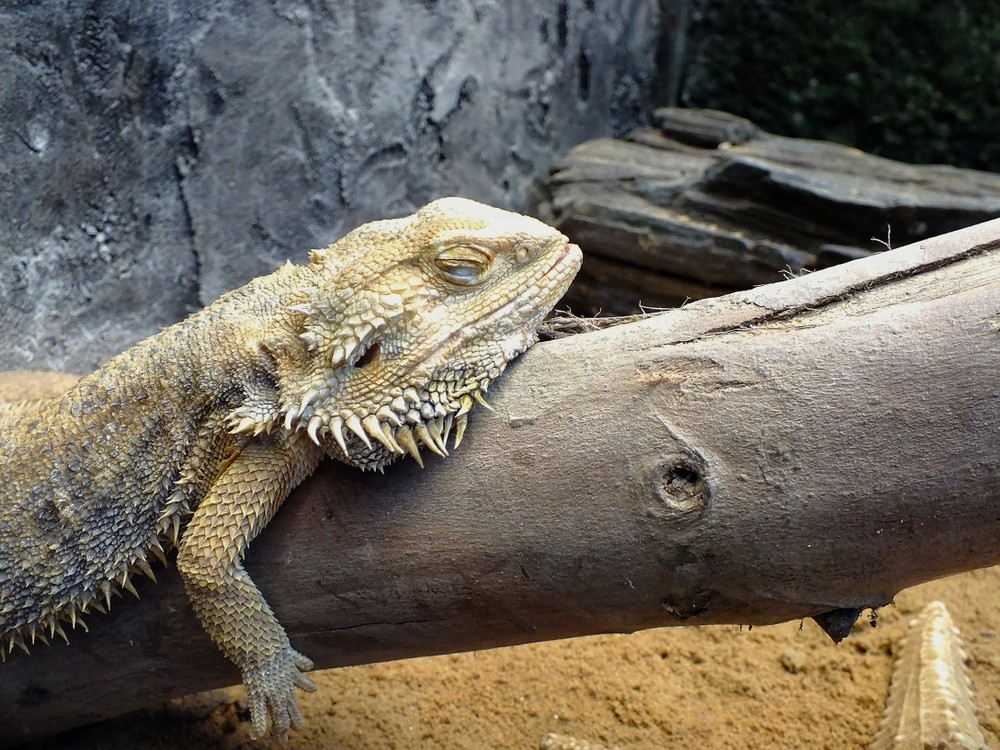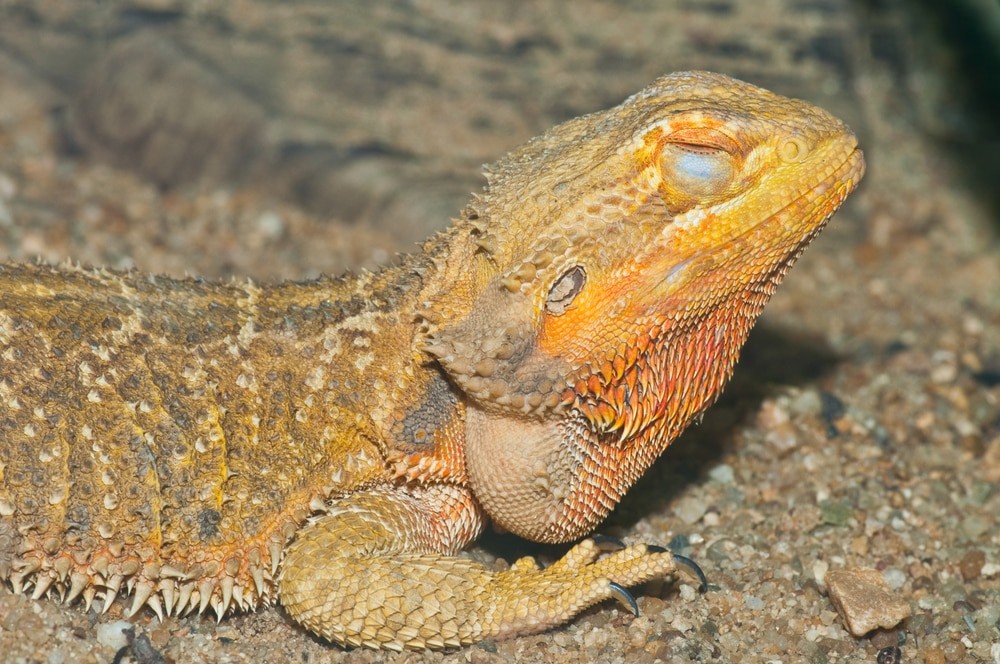Bearded dragons are amazing creatures, not only are these lizards fascinating to look at, but they are also capable of making devoted and beloved pets.
By their nature, bearded dragons are docile and well-mannered reptiles – this means they enjoy being cuddled and are easy to take care of. So if you are looking for a new loving companion or a first-time pet for your children – a bearded dragon is a perfect choice.

Now we understand that the notion of caring for a bearded dragon may be a little daunting. After all, they are lizards and there is a huge separation between looking after a reptile and taking care of a domesticated mammal – like a cat or dog.
So if you are considering buying a bearded dragon, there may be some questions floating around your mind.
Questions like: what do bearded dragons eat? Can you play with them? And probably the most pressing question of all – are bearded dragons nocturnal?
So to help answer your questions, we have compiled all the information you need to know about bearded dragons and their sleeping habits. We have also included 8 interesting facts about these incredible creatures, that you simply won’t believe!
Are Bearded Dragons Nocturnal?
The short and easy answer to this question is no – bearded dragons are not nocturnal animals. The bearded dragon belongs to a diurnal species, which means, like humans, they are active during the day and asleep at night.
In the wild, bearded dragons will often spend their days wandering around in the sun, eventually falling asleep when the sun disappears and night falls.
This is good news for bearded dragon owners, as it means your lizard will usually be asleep when you go to bed.
However, this does not mean that bearded dragons are the most systematic of sleepers, as the cuddly reptiles will often require eight to twelve hours of sleep.
Because bearded dragons go to sleep depending on the darkness of their surroundings, it is recommended that you keep your lizard’s enclosure in a room that is bright during the day and dark during the night.
By doing this you can ensure that your bearded dragon is sleeping for the amount of time it needs to remain rested and healthy.
Bearded Dragons & Sleeping Patterns
Back in 2016, German researchers discovered that bearded dragons share similar sleeping patterns to humans – as well as other mammals and birds.
In a manner very similar to humans, bearded dragons can experience short periods of sleep where they will exhibit rapid eye movements – otherwise known as REM.
The researchers also found that bearded dragons are capable of entering deep states of sleep, which is dubbed slow-wave sleep by professionals.
Although humans share these sleeping patterns with bearded dragons, that is where the similarities end – for bearded dragons have been known to exhibit these patterns in very unique ways.
Whereas the average human will often experience four to five cycles of REM and slow-wave sleep during the night, bearded dragons have been recorded to display a much faster rate of eye movements, which results in hundreds of shorter cycles taking place while they sleep.
Because bearded dragons are capable of exhibiting this behavior during the night – scientists have been able to further understand the properties of sleep, as well as the familial connections between reptiles and birds.
Can Bearded Dragons Close Their Eyes?

Some species of reptiles, such as snakes, are born without eyelids – this means that they are unable to close their eyes while they sleep. However, bearded dragons are born with eyelids and will close their eyes when sleeping or feeling tired.
If your bearded dragon is sleeping and you put on a powerful light, then this could make the reptile open its eyes. Like humans, bearded dragons are very sensitive to light when they are sleeping, and a bright light could disturb or wake them.
Can Bearded Dragons Dream?
Although researchers have discovered that bearded dragons display REM and slow-wave movements during sleep, this still doesn’t confirm whether bearded dragons are capable of dreaming.
When human beings and other mammals experience these particular sleeping patterns, they will usually last for 60-90 minutes at a time.
These cycles will primarily consist of long periods of slow-wave sleep interrupted by short bursts of rapid eye movements. It is during these moments of REM that humans begin to dream – but this is not the same for reptiles.
When bearded dragons are sleeping, these sleeping patterns fall into much shorter and regular cycles, which means they exhibit REM and slow-wave sleep for equal periods during the night.
Because of this, their brains may not have the time or energy to produce dreams – although some scientists believe that bearded dragons may dream in a more fundamental and lateral way.
However, these theories have yet to be proven by any research and it seems we will not know the answer to this question anytime soon. Right now the only experts who know if they dream at night, are the bearded dragons themselves.
8 Interesting Facts About Bearded Dragons!
If you still haven’t learnt enough about these amazing creatures, then we have compiled some interesting facts that may shock and surprise you. Take a look down below and find out more incredible things about these extraordinary reptiles.
1. Bearded Dragons Can Sleep Standing Up
When you keep a bearded dragon as a pet, you may notice how the lizard prefers to sleep on its belly in the middle of its enclosure. However, there are some other positions you may find your bearded dragon sleeping in.
In the wild, bearded dragons have been known to sleep against trees in a vertical position – so you may one day encounter your pet dragon sleeping in a similar way. Although this may look concerning, and a little funny, it is completely natural behavior.
2. Bearded Dragons Can Change Gender
Yes, you read that correctly. Bearded dragons are among a small selection of animals on our planet that are capable of changing their gender – although it seems bearded dragons can only invoke this process while still in their eggs.
Recent studies have shown that male embryos that were incubated above 32C were capable of transforming themselves into females before hatching. Although this isn’t something you have to worry about your bearded dragon doing, it’s still an interesting fact.
3. Bearded Dragons Can Change Color
Many species of reptiles can change color, from geckos to the humble chameleon – and bearded dragons are no exception. Sometimes the change in coloration can be influenced by the bearded dragon’s activities and sleeping patterns.
You may notice that your bearded dragon will take on a lighter hue when it is sleeping or tired – this is completely normal and just another interesting element of their biology.
Bearded dragons will also change color whenever they choose to shed their skin, although the difference may not be noticeable it will happen every time.
4. Bearded Dragons Can Climb Trees
In the wild, bearded dragons have been known to spend their days lounging at the tops of trees. This is because the lizards are arboreal, which means they enjoy climbing trees and bushes.
When keeping a bearded dragon, you should always make sure it has something to climb, as this will help your reptile to grow and maintain mental stimulation.
Because these creatures are capable of climbing to great heights, you can place them on your shoulder without having to be concerned about them falling off. The only downside is that they may try to climb up the side of your head!
5. Bearded Dragons Can Sleep A Long Time
We have previously mentioned how much sleep the bearded dragon needs, but did you know they can also sleep for weeks or months at a time? This process is called Brumation and is the reptilian version of hibernation.
During the winter months, your bearded dragon may hide in its enclosure and sleep until the winter cold has passed. This is a completely natural process and you shouldn’t be concerned.
6. Bearded Dragons Can Produce Venom
Bearded dragons are fascinating creatures and your pet lizard may get some looks from friends or visitors. One thing these people may wonder is if your bearded dragon is venomous or not?
And the answer is – yes they are! Bearded dragons are known to produce a mild poison, which they use to primarily kill and consume prey. But don’t be concerned, this venom is completely harmless to humans and will not affect you in any way.
7. Bearded Dragons Cover Themselves In Sand
We know that bearded dragons have some strange sleeping habits, from sleeping standing up to changing their color – but there is one habit we have yet to discuss.
Some bearded dragons prefer to cover themselves with sand while they sleep – no we are not kidding. Although there is nothing particularly wrong with this behavior, it could mean that your dragon is being bothered by something, like a strong light or noise.
If there’s no reason for your bearded dragon to do this, then chances are that’s just its preference.
8. Bearded Dragons Are Heavy Sleepers
Sometimes bearded dragons can enter such a deep sleep, that you may accidentally think they are dead.
It also doesn’t help that during these periods of sleep, the bearded dragon is capable of slowing down its metabolic and respiratory system, which makes it appear as if the reptile isn’t breathing.
If you notice your bearded dragon in this condition, make sure they are okay and then let them sleep. If there’s nothing to be concerned about then this is a natural behavior.
